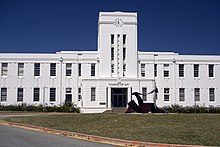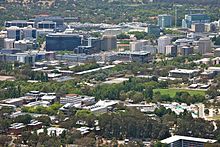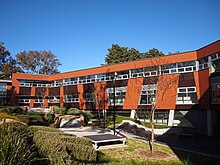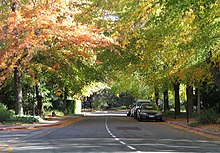Australian National University
Its main campus in Acton encompasses seven teaching and research colleges, in addition to several national academies and institutes.[20] After the location of the nation's capital, Canberra, was determined in 1908, land was set aside for the ANU at the foot of Black Mountain in the city designs by Walter Burley Griffin.The group also included a New Zealander, Sir Raymond Firth (a professor of anthropology at LSE), who had earlier worked in Australia for some years.[20] Economist Sir Douglas Copland was appointed as ANU's first Vice-Chancellor and former Prime Minister Stanley Bruce served as the first Chancellor.[14] Canberra University College (CUC) was the first institution of higher education in the national capital, having been established in 1929 and enrolling its first undergraduate pupils in 1930.[20] Academic leaders at CUC included historian Manning Clark, political scientist Finlay Crisp, poet A. D. Hope and economist Heinz Arndt.[23] In 1960, CUC was integrated into ANU as the School of General Studies, initially with faculties in arts, economics, law and science.ANU is well known for its history of student activism and, in recent years, its fossil fuel divestment campaign, which is one of the longest-running and most successful in the country.[30] The decision of the ANU Council to divest from two fossil fuel companies in 2014 was criticised by ministers in the Abbott government, but defended by Vice Chancellor Ian Young, who noted:On divestment, it is clear we were in the right and played a truly national and international leadership role.[43][44] The main campus of ANU extends across the Canberra suburb of Acton, which consists of 358 acres (1.45 km2) of mostly parkland with university buildings landscaped within.[45] ANU is roughly bisected by Sullivans Creek, part of the Murray–Darling basin, and is bordered by the native bushland of Black Mountain, Lake Burley Griffin, the suburb of Turner and the Canberra central business district.Sidney Nolan's panorama, Riverbend, which comprises nine panels, ís on permanent display at the Drill Hall Gallery."[64][65][66][67] Its president is Nicholas Southwood and key people include Seth Lazar, Geoff Brennan, Bob Goodin, Frank Jackson, Philip Pettit and Michael Smith.[when?[84] Under the direction of Mark Oliphant, nuclear physics was one of the university's most notable early research priorities, leading to the construction of a 500 megajoule homopolar generator and a 7.7 megaelectronvolts cyclotron in the 1950s.[86] Brian Schmidt (astrophysicist at Mount Stromlo Observatory) received the 2011 Nobel Prize for Physics for his work on the accelerating expansion of the universe.[88] Three further Nobel Prizes have been won as a result of research at JCSMR—in 1963 by John Eccles and in 1996 by Peter Doherty and Rolf M. Zinkernagel.[119] The Australian National University Union manages catering and retail outlets and function amenities on behalf of all students.Bob Hawke and Kevin Rudd, former Australian Prime Ministers, attended the university, as did senior politicians Annastacia Palaszczuk, Barry O'Farrell, Nick Minchin, Kim Beazley Sr, Peter Garrett, Craig Emerson, Stephen Conroy, Gary Gray, Warren Snowdon, Joe Ludwig and Catherine King and Michael Keenan.Other notable alumni include High Court of Australia judges Stephen Gageler and Geoffrey Nettle, Fijian archaeologist Tarisi Vunidilo, Wallisian member of the Congress of New Caledonia Ilaïsaane Lauouvéa, Chinese businessman Tiger Lin, Chief Federal Magistrate John Pascoe, political journalist Stan Grant, human rights lawyer Jennifer Robinson, former Chief of Army David Morrison, Kellogg's CEO John Bryant, former Singapore Airlines CEO Cheong Choong Kong, Indiana University president Michael McRobbie, University of Melbourne Vice-Chancellors Alan Gilbert and Glyn Davis, mathematician John H. Coates, computer programmer Andrew Tridgell, public intellectual Clive Hamilton, journalist Bettina Arndt, and economists John Deeble, Ross Garnaut, Peter Drysdale, John Quiggin and commercial litigator Jozef Maynard Borja Erece, the youngest law graduate in Australian history.Notable past faculty include Mark Oliphant, Keith Hancock, Manning Clark, Derek Freeman, H. C. Coombs, Gareth Evans, John Crawford, Hedley Bull, Frank Fenner, C. P. Fitzgerald, Pierre Ryckmans, A. L. Basham, Bernhard Neumann, and former Indonesian Vice-president Boediono.[18] Notable present scholars include Hilary Charlesworth, Ian McAllister, Hugh White, Warwick McKibbin, Keith Dowding, Amin Saikal and Jeremy Shearmur.Notable Honorary Doctorate recipients have included former Australian public officials Stanley Bruce, Robert Menzies, Richard Casey, Angus Houston, Brendan Nelson, Owen Dixon, Australian notable persons Sidney Nolan, Norman Gregg, Charles Bean, foreign dignitaries Harold Macmillan, Lee Kuan Yew, Aung San Suu Kyi, Sheikh Hasina, K. R. Narayanan, Nelson Mandela, Desmond Tutu, Saburo Okita and notable foreign scientists John Cockcroft, Jan Hendrik Oort and Alexander R. Todd.[126] ANU Chancellor Julie Bishop later called for the ACT government to explain why the university was not informed of the risk beforehand.











ANU (disambiguation)Coat of armsPublicnationalresearch universityGroup of EightEndowmentmillionbillionChancellorJulie BishopVice-ChancellorGenevieve BellUndergraduatesPostgraduatesCanberraAustralian Capital TerritoryAustraliaregionalColoursNicknameUniSportParliament of AustraliaCanberra University CollegeNobel laureatesRhodes scholarsfaculty and alumniGovernor-General of Australiaprime ministersgovernment departments of AustraliaANU Pressnational universityBlack MountainWalter Burley GriffinWorld War IIDepartment of Post-War ReconstructionChifley governmenthomopolar generatorHoward FloreypenicillinMark OliphantManhattan ProjectKeith HancockChichele Professor of Economic HistoryOxfordRaymond FirthDouglas CoplandStanley BruceJohn Curtin School of Medical ResearchUniversity HouseMount Stromlo ObservatoryANU LibraryRobert GarranAustralian ConstitutionSolicitor-General of AustraliaUniversity of MelbourneManning ClarkFinlay CrispA. D. HopeHeinz ArndtOriental studiesCanberra High SchoolCanberra School of MusicMedical SchoolCanberra bushfiresSiding Spring ObservatoryAnglo-Australian TelescopeGraham Tuckwellstudent activismfossil fuel divestment campaignAbbott governmentAustralian Human Rights CommissionSchool of MusicNational University of SingaporeUniversity of TokyoUniversity of Hong KongPeking UniversityTsinghua UniversitySeoul National UniversityGeorge Washington UniversityUniversity of CaliforniaUniversity of TexasUniversity of TorontoImperial College LondonKing's College LondonSciences PoETH ZürichBocconi UniversityUniversity of CopenhagenTrinity College DublinChinese hackersSullivans CreekMurray–Darling basinLake Burley GriffinTurnercentral business districtlearned societiesAustralian Academy of ScienceAustralian Academy of the HumanitiesAcademy of the Social Sciences in AustraliaAustralian National Centre for the Public Awareness of ScienceNational Film and Sound ArchiveNational Museum of AustraliaCoonabarabranKioloaSouth CoastDarwindrill hallSecond World War3rd Battalion, Werriwa Regimentart galleryheritage-listedNational Gallery of AustraliaSidney NolanGareth EvansForeign Minister of AustraliaBrian SchmidtAcademic structure of the Australian National UniversityHistoryPhilosophySociologyPoliticsInternational RelationsDemographyIslamicEuropean Studies